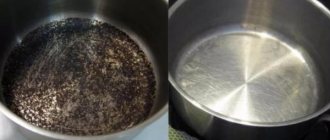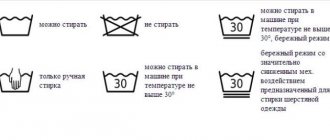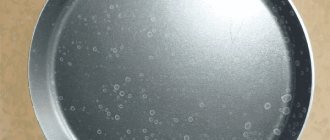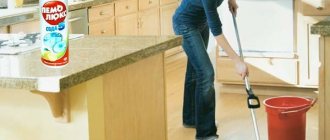Induction cookers have been in everyday life for quite some time. They look very aesthetically pleasing, safe and practical. But the difficulty is that not all dishes fit. Before leaving the pan on the surface, you need to pay attention to whether there is an induction sign on the frying pan or saucepan. You can also check with the seller, but it is better to understand what features this type of stove has.
Designation of cookware suitable for induction cookers.
Features of cookware
Kitchen utensils made of steel are suitable for use on an induction hob. But in order for the efficiency of use to be higher, you need to choose the right dishes. Steel products have resistance to magnetic energy, which contributes to rapid heating.
But products made from other materials, such as ceramics or glass, do not heat up on the induction surface, because these materials transmit the magnetic field. They heat up very slowly, so it is best not to use them.
A special symbol is placed on the cookware if it can be used for an induction cooker.
Conclusion
Energy saving is becoming really popular, but one of the downsides is that you only need induction cookware. Below are the simple steps you can use to check whether your cookware is induction or not:
- The utensils must be iron or metal based;
- The base must be flat so that it can conduct the magnetic field;
- Fill a pan with water, place it on the induction hob (in the area marked for cookware) and turn it on. If it starts to heat up, your cookware is induction.
What is the designation for induction cookware?
The induction symbol looks like a wavy, rounded spiral. This sign was not chosen in vain, because the spiral is the main heating element. It is through it that the current flows, which heats the stove.
This icon is the standard marking for any cookware in any country, from various manufacturers and brands. This designation is intuitive.
The pot and pan are suitable for cooking on an induction hob.
What kind of induction signs are there?
The method of magnetic induction is studied at school. Everyone knows how an induction coil is designated: it is a vertically located multi-turn spiral and a line parallel to the axis of the turns. The international physical symbol used in electrical circuit diagrams is used only by some European manufacturers to mark cookware.
The designation that determines the suitability of a particular cookware for use in combination with an induction cooker is presented in the form of a horizontal spiral enclosed in a square outline.
What other icons are there on cookware for induction cookers:
- It is customary to indicate induction with several stylized loops, there are 4 or 5 of them.
- Draw several turns of the spiral horizontally.
- They make schematic zigzags.
Hold a small magnet to the bottom of the pan or pan. If magnetization and attraction occurs, then the container can be used on an induction cooker without fear.
Many limit themselves to the inscription “Induction”. Branded companies combine a sign and an inscription in a marking square. The designation is made in the form of a pictogram.
Read also: delicate green IN COLOR BALANCE
The sign was not chosen by chance. A spiral is a symbol of the electromagnetic field created by an induction coil. Induced fields are called induction.
The location of the mark may vary depending on the model and design of the cookware.
Note! Pots for stoves with an induction sensor are made wide and low.
Where are the icons placed on the cookware for the induction cooker?
Depending on the type of structure, induction marks are placed in different places. Especially:
- in frying pans you need to look for it at the bottom;
- on pans this designation can be not only on the bottom, but also on the wall.
Always, if a product is sold with a box, such a mark is placed on it. Most often, badges are engraved on the product, which will ensure its safety.
Some manufacturers, in addition to the pictogram, include the inscription Induction. Perhaps the product will only have an inscription.
Answers on questions
Most happy owners of an economical and safe stove do not know the answers to simple questions; therefore, before purchasing household appliances, you should read the manufacturer’s instructions. In order not to damage the hob the first time you use it, you need to know a few nuances.
What kind of pan should not be placed on the stove?
There is no direct contact between the burner and the pan, which has an uneven bottom, which leads to uneven heating and loss of efficiency. It is desirable that the bottom of the dish be multi-layered and at least 5 mm thick.
In this case, if the bottom surface is uneven, induction will be ineffective, which will increase cooking time and energy consumption. The hob simply will not heat other dishes made of glass, ceramics or non-magnetic metals without a special adapter.
Are cookware with a special bottom suitable for gas and electricity?
There are no restrictions. Special cookware adapted for induction has a metal plate at the bottom, which heats up and transfers heat to the entire pot or pan. Also, this type of kitchen utensil can be used on gas and electric burners, and can also be placed in the oven.
When purchasing an induction hob, you should immediately think about being ready to replace old cookware with new ones, but this is not necessary. You can buy an adapter and not think about throwing away your favorite glass saucepan, but buy special utensils as needed.
What other markings exist for dishes?
Different kitchen equipment has its own safety precautions and method of operation. That is why you need to pay attention to the pictograms that are on the utensils. Almost all icons are intuitive even for inexperienced users.
For example:
- one flame or several flames means suitability for use on a gas stove;
- the oven icon means that the cookware can be used in the oven; it is often accompanied by numbers that indicate the maximum temperature;
- thermometer means resistance to temperature changes;
- a snowflake indicates suitability for storing food in the refrigerator, and if there are three of them, then also for the freezer;
- the image of a microwave oven indicates the suitability of the dishes for cooking in this type of oven;
- The apple indicates that the beneficial properties are preserved during cooking.
Example of marking a frying pan.
These symbols, just like the induction symbol, are placed on the bottom of the product, on the side and on the packaging.
Labeling according to cooking methods
Let's move on to the explanations of the pictograms. Let's start by deciphering the drawings by type of slabs. The following symbols may be indicated on the bottom:
- burner with flames - for cooking on gas;
- “pancake” - for a stove with electric heating elements;
- a circle that looks like a spider's web or with dotted lines inside - the product is suitable for a glass-ceramic hob;
- spiral or “loops” - the now familiar induction symbol on a pan;
- circle with a complex pattern - you can use a pan on a halogen stove.
- A miniature drawing depicting an oven suggests that such a container can be used for baking and stewing in any oven. But there are nuances:
- the inscription “electric” in the picture means that the utensil is suitable for an electric oven;
- oven with flames - gas cooking is allowed;
- The number in the figure means that the pot or pan can only be heated to a certain temperature.
Precautionary measures
When using some materials, you need to be aware that there are some precautions. Here are some popular ones:
- cast iron. It is suitable for induction cookers because it is highly magnetic. Labeled cookware or those with a symbol of suitability for electric stoves are suitable. It is only important that the cast iron frying pan has a smooth, clean bottom, without any damage or soot;
- non-stick coated steel will also work. But, it is better that the bottom is thick and there is a layer of enamel or other coating on the alloy;
- Convenient and practical stainless steel can only become suitable if the metal alloy contains some impurities that can be magnetized. Before use, you need to check the bottom with a magnet;
- ceramics and glass are not suitable, because they will not heat up in a magnetic field;
- aluminum will also not be able to be used. This is due to the properties of the metal; it is not magnetic, but at high temperatures it can become deformed;
- old utensils made of copper, bronze or brass will not work, because they are not designed for an induction sensor.
Utensils that are suitable for an induction cooker can be cleaned in the dishwasher, unless there are contraindications specifically for the material.
Adapter for using any utensils.
How to tell if cookware is induction compatible if there are no icons
When going to the store, you should grab a magnet from the refrigerator. It is used to test unmarked utensils. If the souvenir “sticks”, it means there is a layer of iron that will heat up under the influence of electromagnetic waves. The second important criterion is the quality of the bottom. On cookware for gas stoves, flame-cutting grooves are often made, radiating like rays from the center. This container will heat up slowly.
When using cookware with a thick bottom on an induction cooker, its heating coefficient increases.
When purchasing an induction cooker, do not rush to part with your favorite frying pans and pots of a convenient format. It is a myth that dishes must be labeled. Not all manufacturers specialize in producing products recognized by inductive sensors.
A thick layer of metal better restrains the magnetic field of the plate, which leads to a reduction in heating time.
There are only a few restrictions on the types of materials for induction; some old utensils can be used on a new stove.
Features of popular materials.
- Cast iron is rarely marked, but is ideal for induction cookers and has excellent magnetism. The bottom of the vessel should be flat, tightly adjacent to the surface of the stove. You can safely buy cast iron frying pans with a wide bottom, pots and saucepans marked for electric stoves. Such cast iron utensils are universal; you can use them to fry soups, prepare liquid main courses, and rich aromatic soups.
The bottom of the cookware for induction cookers is made of materials with magnetic properties.
Important! The contours of the burner are marked on the hob; the bottom of the pan should overlap them. It is better to place small duck pots with a narrow bottom and cast iron utensils with a raised bottom on the adapter, then the food will cook quickly and the stove will not be under stress.
- Carbon alloys are necessarily coated with a layer of enamel or non-stick coating. It is better to choose steel with a thickened bottom. Wide, heavy enamel dishes with a thick bottom and walls are the most practical. It cooks food quickly. Non-stick coated steel is less durable.
When purchasing, you should pay attention to the production material of the cookware.
Note! The steel on the tile must be constantly monitored; thin metal can melt if overheated.
- For cookware made of stainless alloys, testing using a magnet is mandatory. The alloy contains large quantities of non-ferrous metals with paramagnetic properties. Pots, saucepans, and frying pans made of stainless steel must have a ferromagnetic liner on the bottom. If there is a capsule insert, the magnet will be attracted. If the container does not have an encapsulated bottom, the dishes will not heat up. You will have to give up your favorite utensils.
Induction cookware is much larger than standard containers.
Important! Cookware for induction cookers should be thoroughly rinsed. Residues of fat form coke deposits and are difficult to remove from the cooking surface.
- Ceramic and glass without a reinforced bottom should be discarded; these materials are NOT intended for induction cookers. Lovers of natural, eco-friendly materials will have to purchase special items for cooking. A steel capsule or a steel/aluminum sandwich is soldered into the glass. An additional coating is applied to the ceramics.
The structure of the special disk contains magnetic particles that contact the panel.
- Aluminum is not suitable for two reasons: it does not respond to electromagnetic fields; Over time, the bottom of the vessel becomes rounded, and the metal deforms from heating.
- Copper, brass, bronze, alloyed with ferromagnetic metals, are magnetic, but there are too few heating components in the alloy, the bottom will heat up slowly. The material is extremely inconvenient for an inductive sensor and is difficult to recognize.
Branded companies delight consumers with unique lines of cookware that simplify the cooking process.
Note! For cooking on an induction hob, the bottom of the cookware is made of 3–6 layers. Important components: ferromagnetic layer that creates heating; aluminum gasket that retains heat; anti-deformation disc that fits tightly to the glass-ceramic surface of the plate.
Adapter
There is one trick that housewives will like if they do not want to give up their favorite kitchen utensils, but attach them to the induction surface. This is a special adapter that is placed on the hob to allow any type of cookware to be installed on it. This adapter is universal, but you need to get used to cooking with it.
Previous
Frying pansHow to clean a ceramic frying pan from carbon deposits
Next
PansHow to store pans in the kitchen: classic and original ideas
What to buy: choosing the minimum required for cooking
The best option would be a set of four-piece cookware with a bottom size that completely matches the diameter of the burners. Such kits are easy to find in specialized stores that sell kitchen utensils.
When purchasing, it is worth considering that it is better to purchase a pan with a smaller height and a wider bottom - this will optimize the heating efficiency. Usually the set includes: a frying pan and three cooking pots for 5.3 and 2 liters, but with a large selection in stores, you can easily choose your own option.
Hob care
A stove with a glass-ceramic panel requires specific care. In order for it to remain in good condition for as long as possible and to please you with cleanliness during operation, you need to listen to the following advice:
- Do not place wet dishes on the glass-ceramic surface. Heating a pan with a wet bottom will cause white spots to appear. It will be very difficult to get rid of such divorces.
- Do not use a dish sponge for cleaning. Residues of fat and food particles can leave scratches and other damage. This should be a separate thick cloth intended exclusively for wiping the fragile panel.
- Do not allow sugar or plastic to come into contact with the surface. When heated, substances will begin to melt and eat into the surface.
- Any contamination from the induction type surface must be removed immediately. Dried dirt can be removed with a special household scraper. You can replace it with a regular razor or a melamine sponge.
- For difficult stains, use only mild products. The glass-ceramic surface can only be cleaned using a gentle method. Hard metal scourers and abrasives should not be used. The stains must be covered with baking soda, covered with a damp cloth, and left for 10 minutes.
- Creation of a protective thin film. The desired screen film will be obtained if you wipe the clean surface with a napkin soaked in vegetable oil. Dust, small particles of paper napkins, and crumbs will not settle on such a stove.
Hob types
Depending on the connection method, hobs can be autonomous or dependent on the heating element. All glass-ceramic models have high, easily adjustable thermal conductivity. The following types of hob surfaces are most commonly used:
- Electrical. They stand out for their huge functionality. When choosing such a model, you should take into account the large load on the electrical wiring. It must withstand high voltage. The hob is completely covered with a glass-ceramic hob. The burners are round or oval.
- Induction. Modern simple devices that are gradually replacing other types of surfaces. Practical, durable models equipped with advanced features. Economical equipment instantly heats the burner and automatically turns off if there are no containers on it.
- Gas. Reliable plates are able to work in the most extreme conditions. Modern glass-ceramic coating can withstand the effects of combustion and high temperatures on a par with metal surfaces.
Basic requirements for dishes
Hob manufacturers recommend using metal pots and pans that meet all requirements. The cookware must have a flat, even bottom to ensure the best heat transfer. If the bottom of the item is deformed, the burner itself will overheat, which will shorten its service life. Even small air gaps between the surface and bottom of the cookware reduce heat transfer. There should be no embossed manufacturer's marks, relief patterns, or other roughness.
The bottom of the dish must have a minimum reflection coefficient. Matte dark surfaces are preferable. It must be dense enough to prevent deformation under the influence of high temperature. If the thickness of the bottom is not enough, there is a high probability of sagging, which will lead to a decrease in the tightness of the bottom to the surface of the electric stove.
To avoid overheating, the cookware and burner must be the same diameter. Heat is dissipated very poorly from the uncovered part of the element. If the edges of the bottom of the pan extend beyond the burner, there will not be enough power for full heating.
Manufacturers of stoves and glass-ceramic surfaces recommend using pots and pans with concave bottoms. This design will ensure a tight fit and efficient use of heat.











